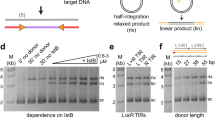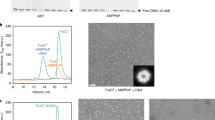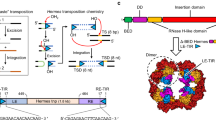Abstract
THAP-family C2CH zinc-coordinating DNA-binding proteins function in diverse eukaryotic cellular processes, such as transposition, transcriptional repression, stem-cell pluripotency, angiogenesis and neurological function. To determine the molecular basis for sequence-specific DNA recognition by THAP proteins, we solved the crystal structure of the Drosophila melanogaster P element transposase THAP domain (DmTHAP) in complex with a natural 10-base-pair site. In contrast to C2H2 zinc fingers, DmTHAP docks a conserved β-sheet into the major groove and a basic C-terminal loop into the adjacent minor groove. We confirmed specific protein-DNA interactions by mutagenesis and DNA-binding assays. Sequence analysis of natural and in vitro–selected binding sites suggests that several THAPs (DmTHAP and human THAP1 and THAP9) recognize a bipartite TXXGGGX(A/T) consensus motif; homology suggests THAP proteins bind DNA through a bipartite interaction. These findings reveal the conserved mechanisms by which THAP-family proteins engage specific chromosomal target elements.
This is a preview of subscription content, access via your institution
Access options
Subscribe to this journal
Receive 12 print issues and online access
$189.00 per year
only $15.75 per issue
Buy this article
- Purchase on Springer Link
- Instant access to full article PDF
Prices may be subject to local taxes which are calculated during checkout





Similar content being viewed by others
References
Lee, C.C., Beall, E.L. & Rio, D.C. DNA binding by the KP repressor protein inhibits P-element transposase activity in vitro. EMBO J. 17, 4166–4174 (1998).
Lee, C.C., Mul, Y.M. & Rio, D.C. The Drosophila P-element KP repressor protein dimerizes and interacts with multiple sites on P-element DNA. Mol. Cell. Biol. 16, 5616–5622 (1996).
Finn, R.D. et al. The Pfam protein families database. Nucleic Acids Res. 36, D281–D288 (2008).
Roussigne, M. et al. The THAP domain: a novel protein motif with similarity to the DNA-binding domain of P element transposase. Trends Biochem. Sci. 28, 66–69 (2003).
Quesneville, H., Nouaud, D. & Anxolabehere, D. Recurrent recruitment of the THAP DNA-binding domain and molecular domestication of the P-transposable element. Mol. Biol. Evol. 22, 741–746 (2005).
Nicholas, H.R., Lowry, J.A., Wu, T. & Crossley, M. The Caenorhabditis elegans protein CTBP-1 defines a new group of THAP domain-containing CtBP corepressors. J. Mol. Biol. 375, 1–11 (2008).
Bessiere, D. et al. Structure-function analysis of the THAP zinc finger of THAP1, a large C2CH DNA-binding module linked to Rb/E2F pathways. J. Biol. Chem. 283, 4352–4363 (2008).
Clouaire, T. et al. The THAP domain of THAP1 is a large C2CH module with zinc-dependent sequence-specific DNA-binding activity. Proc. Natl. Acad. Sci. USA 102, 6907–6912 (2005).
Fuchs, T. et al. Mutations in the THAP1 gene are responsible for DYT6 primary torsion dystonia. Nat. Genet. 41, 286–288 (2009).
Wolfe, S.A., Nekludova, L. & Pabo,, C.O. DNA recognition by Cys2His2 zinc finger proteins. Annu. Rev. Biophys. Biomol. Struct. 29, 183–212 (2000).
Luscombe, N.M., Austin, S.E., Berman, H.M. & Thornton, J.M. An overview of the structures of protein-DNA complexes. Genome Biol. 1 reviews001.1–001.10 (2000).
Liew, C.K., Crossley, M., Mackay, J.P. & Nicholas, H.R. Solution structure of the THAP domain from Caenorhabditis elegans C-terminal binding protein (CtBP). J. Mol. Biol. 366, 382–390 (2007).
Hammer, S.E., Strehl, S. & Hagemann, S. Homologs of Drosophila P transposons were mobile in zebrafish but have been domesticated in a common ancestor of chicken and human. Mol. Biol. Evol. 22, 833–844 (2005).
Macfarlan, T. et al. Human THAP7 is a chromatin-associated, histone tail-binding protein that represses transcription via recruitment of HDAC3 and nuclear hormone receptor corepressor. J. Biol. Chem. 280, 7346–7358 (2005).
Macfarlan, T., Parker, J.B., Nagata, K. & Chakravarti, D. Thanatos-associated protein 7 associates with template activating factor-Iβ and inhibits histone acetylation to repress transcription. Mol. Endocrinol. 20, 335–347 (2006).
Lin, Y., Khokhlatchev, A., Figeys, D. & Avruch, J. Death-associated protein 4 binds MST1 and augments MST1-induced apoptosis. J. Biol. Chem. 277, 47991–48001 (2002).
Roussigne, M., Cayrol, C., Clouaire, T., Amalric, F. & Girard, J.P. THAP1 is a nuclear proapoptotic factor that links prostate-apoptosis-response-4 (Par-4) to PML nuclear bodies. Oncogene 22, 2432–2442 (2003).
Balakrishnan, M.P. et al. THAP5 is a human cardiac-specific inhibitor of cell cycle that is cleaved by the proapoptotic Omi/HtrA2 protease during cell death. Am. J. Physiol. Heart Circ. Physiol. 297, H643–H653 (2009).
Dejosez, M. et al. Ronin is essential for embryogenesis and the pluripotency of mouse embryonic stem cells. Cell 133, 1162–1174 (2008).
Cayrol, C. et al. The THAP-zinc finger protein THAP1 regulates endothelial cell proliferation through modulation of pRB/E2F cell-cycle target genes. Blood 109, 584–594 (2007).
De Souza Santos, E., De Bessa, S.A., Netto, M.M. & Nagai, M.A. Silencing of LRRC49 and THAP10 genes by bidirectional promoter hypermethylation is a frequent event in breast cancer. Int. J. Oncol. 33, 25–31 (2008).
Zhu, C.Y. et al. Cell growth suppression by thanatos-associated protein 11(THAP11) is mediated by transcriptional downregulation of c-Myc. Cell Death Differ. 16, 395–405 (2009).
Luscombe, N.M., Laskowski, R.A. & Thornton, J.M. Amino acid-base interactions: a three-dimensional analysis of protein-DNA interactions at an atomic level. Nucleic Acids Res. 29, 2860–2874 (2001).
Kaufman, P.D., Doll, R.F. & Rio, D.C. Drosophila P element transposase recognizes internal P element DNA sequences. Cell 59, 359–371 (1989).
Pavletich, N.P. & Pabo, C.O. Zinc finger-DNA recognition: crystal structure of a Zif268-DNA complex at 2.1 A. Science 252, 809–817 (1991).
Suzuki, M. DNA recognition by a β-sheet. Protein Eng. 8, 1–4 (1995).
Fadeev, E.A., Sam, M.D. & Clubb, R.T. NMR structure of the amino-terminal domain of the λ integrase protein in complex with DNA: immobilization of a flexible tail facilitates β-sheet recognition of the major groove. J. Mol. Biol. 388, 682–690 (2009).
Wojciak, J.M., Connolly, K.M. & Clubb, R.T. NMR structure of the Tn916 integrase-DNA complex. Nat. Struct. Biol. 6, 366–373 (1999).
Geierstanger, B.H., Volkman, B.F., Kremer, W. & Wemmer, D.E. Short peptide fragments derived from HMG-I/Y proteins bind specifically to the minor groove of DNA. Biochemistry 33, 5347–5355 (1994).
Schneider, T.D. Strong minor groove base conservation in sequence logos implies DNA distortion or base flipping during replication and transcription initiation. Nucleic Acids Res. 29, 4881–4891 (2001).
Muller, U. The monogenic primary dystonias. Brain 132, 2005–2025 (2009).
Elrod-Erickson, M., Rould, M.A., Nekludova, L. & Pabo, C.O. Zif268 protein-DNA complex refined at 1.6 Å: a model system for understanding zinc finger-DNA interactions. Structure 4, 1171–1180 (1996).
Schildbach, J.F., Karzai, A.W., Raumann, B.E. & Sauer, R.T. Origins of DNA-binding specificity: role of protein contacts with the DNA backbone. Proc. Natl. Acad. Sci. USA 96, 811–817 (1999).
Somers, W.S. & Phillips, S.E. Crystal structure of the met repressor-operator complex at 2.8 Å resolution reveals DNA recognition by β-strands. Nature 359, 387–393 (1992).
Otwinowski, Z. & Minor, W. Processing of X-ray diffraction data collected in oscillation mode. in Methods in Enzymology Vol. 276 (eds. Carter, C.W.J. & Sweet, R.M.) 307–325 (Academic Press, Boston, 1997).
Zwart, P.H. et al. Automated structure solution with the PHENIX suite. Methods Mol. Biol. 426, 419–435 (2008).
Terwilliger, T.C. Maximum-likelihood density modification. Acta Crystallogr. D Biol. Crystallogr. 56, 965–972 (2000).
Terwilliger, T.C. Maximum-likelihood density modification using pattern recognition of structural motifs. Acta Crystallogr. D Biol. Crystallogr. 57, 1755–1762 (2001).
Adams, P.D. et al. PHENIX: building new software for automated crystallographic structure determination. Acta Crystallogr. D Biol. Crystallogr. 58, 1948–1954 (2002).
Emsley, P. & Cowtan, K. Coot: model-building tools for molecular graphics. Acta Crystallogr. D Biol. Crystallogr. 60, 2126–2132 (2004).
Murshudov, G.N., Vagin, A.A. & Dodson, E.J. Refinement of macromolecular structures by the maximum-likelihood method. Acta Crystallogr. D Biol. Crystallogr. 53, 240–255 (1997).
Vaguine, A.A., Richelle, J. & Wodak, S.J. SFCHECK: a unified set of procedures for evaluating the quality of macromolecular structure-factor data and their agreement with the atomic model. Acta Crystallogr. D Biol. Crystallogr. 55, 191–205 (1999).
Laskowski, R.A., MacArthur, M.W., Moss, D.S. & Thornton, J.M. PROCHECK: A program to check the stereochemical quality of protein structures. J. Appl. Crystallogr. 26, 283–291 (1993).
DeLano, W.L. The PyMOL Molecular Graphics System (DeLano Scientific, San Carlos, California, USA, 2002).
Kelley, L.A. & Sternberg, M.J. Protein structure prediction on the Web: a case study using the Phyre server. Nat. Protoc. 4, 363–371 (2009).
Lu, X.J. & Olson, W.K. 3DNA: a versatile, integrated software system for the analysis, rebuilding and visualization of three-dimensional nucleic-acid structures. Nat. Protoc. 3, 1213–1227 (2008).
Lavery, R., Moakher, M., Maddocks, J.H., Petkeviciute, D. & Zakrzewska, K. Conformational analysis of nucleic acids revisited: Curves+. Nucleic Acids Res. 37, 5917–5929 (2009).
Poirot, O., Suhre, K., Abergel, C., O′Toole, E. & Notredame, C. 3DCoffee@igs: a web server for combining sequences and structures into a multiple sequence alignment. Nucleic Acids Res. 32, W37–40 (2004).
O'Sullivan, O., Suhre, K., Abergel, C., Higgins, D.G. & Notredame, C. 3DCoffee: combining protein sequences and structures within multiple sequence alignments. J. Mol. Biol. 340, 385–395 (2004).
Waterhouse, A.M., Procter, J.B., Martin, D.M., Clamp, M. & Barton, G.J. Jalview Version 2: a multiple sequence alignment editor and analysis workbench. Bioinformatics 25, 1189–1191 (2009).
Roulet, E. et al. High-throughput SELEX SAGE method for quantitative modeling of transcription-factor binding sites. Nat. Biotechnol. 20, 831–835 (2002).
Schneider, T.D., Stormo, G.D., Yarus, M.A. & Gold, L. Delila system tools. Nucleic Acids Res. 12, 129–140 (1984).
Acknowledgements
The authors would like to thank J. Gureasko and J. Kuriyan (Univ. California, Berkeley) for use of equipment and technical expertise, E. Abbate and M. Botchan (Univ. California, Berkeley) for crystallography supplies and experimental design, N. Echols and T. Alber (Univ. California, Berkeley) for use of equipment and assistance with data collection, J. Holton for assistance with data collection, A. May (Fluidigm) for crystallography supplies and assistance with data collection, D. King (Univ. California, Berkeley, and Howard Hughes Medical Institute Mass Spectrometry Laboratory) for MS analysis, N. Ogowa and M. Biggin (Univ. California, Berkeley) for reagents and expertise for the SELEX protocol, R. Schultzaberger and M. Eisen for assistance with SELEX data analysis and for creating the sequence logos, K. Collins for data analysis and D. Wemmer, M. Levine and M. Botchan for critical reading of the manuscript. A.Y.L. is supported by an American Cancer Society postdoctoral fellowship, J.M.B. by the US National Cancer Institute (CA077307) and D.C.R. by the National Institute of General Medical Sciences (GM61987).
Author information
Authors and Affiliations
Contributions
A.S. and D.C.R. conceived the experiments; D.C.R. synthesized brominated DNA oligonucleotides; A.S. purified the proteins and nucleic acids and crystallized the complex; J.E.C., A.Y.L. and J.M.B. provided guidance in crystallography trials; A.Y.L. and A.S. collected and analyzed the structural data; J.M.B. assisted with model building and refinement; A.Y.L. solved the structure and made all structural models; A.S. performed the DmTHAP mutagenesis and biochemistry, the SELEX experiment for human THAP9 and the THAP DNA-binding-site sequence analysis; A.S., A.Y.L., J.M.B. and D.C.R. wrote the paper.
Corresponding author
Supplementary information
Supplementary Text and Figures
Supplementary Figures 1–5 (PDF 789 kb)
Rights and permissions
About this article
Cite this article
Sabogal, A., Lyubimov, A., Corn, J. et al. THAP proteins target specific DNA sites through bipartite recognition of adjacent major and minor grooves. Nat Struct Mol Biol 17, 117–123 (2010). https://doi.org/10.1038/nsmb.1742
Received:
Accepted:
Published:
Issue Date:
DOI: https://doi.org/10.1038/nsmb.1742
This article is cited by
-
NMR studies of a new family of DNA binding proteins: the THAP proteins
Journal of Biomolecular NMR (2013)
-
Reliability of the nanopheres-DNA immunization technology to produce polyclonal antibodies directed against human neogenic proteins
Molecular Genetics and Genomics (2013)
-
Re-visiting protein-centric two-tier classification of existing DNA-protein complexes
BMC Bioinformatics (2012)
-
A comparative analysis of DNA methylation across human embryonic stem cell lines
Genome Biology (2011)



